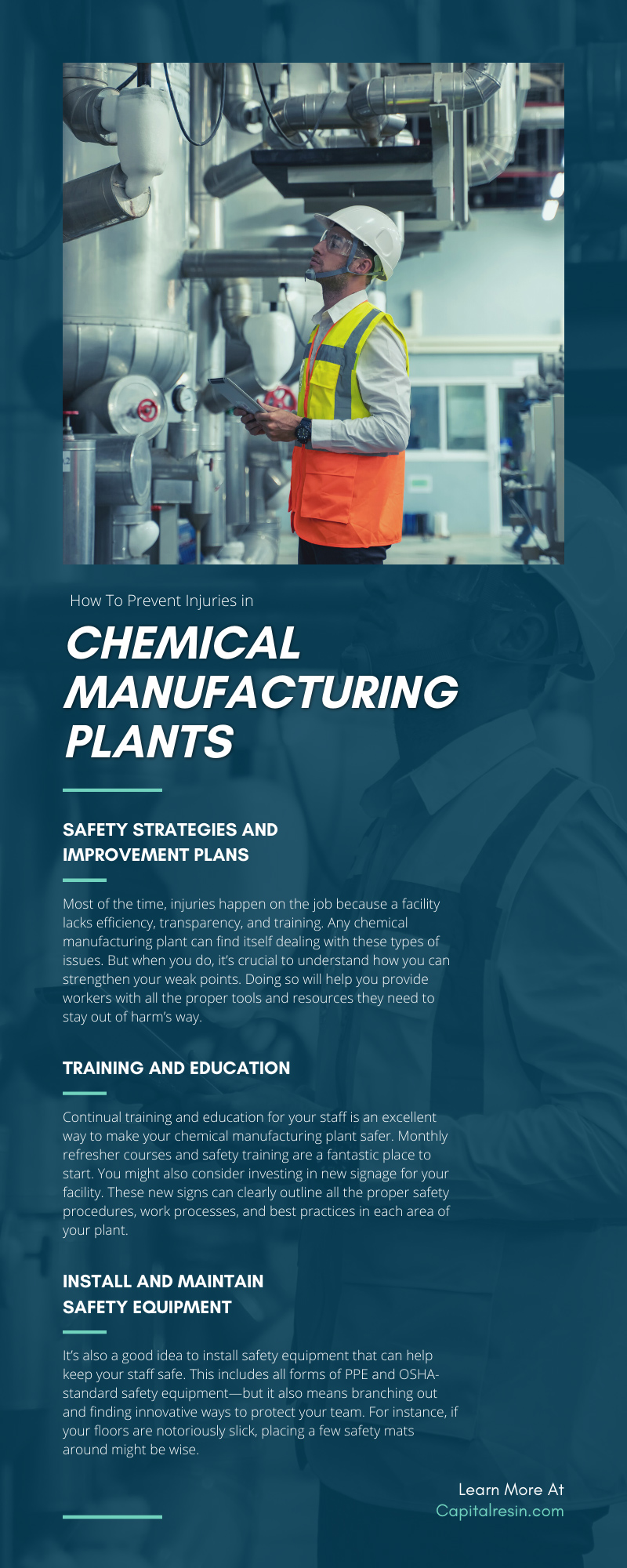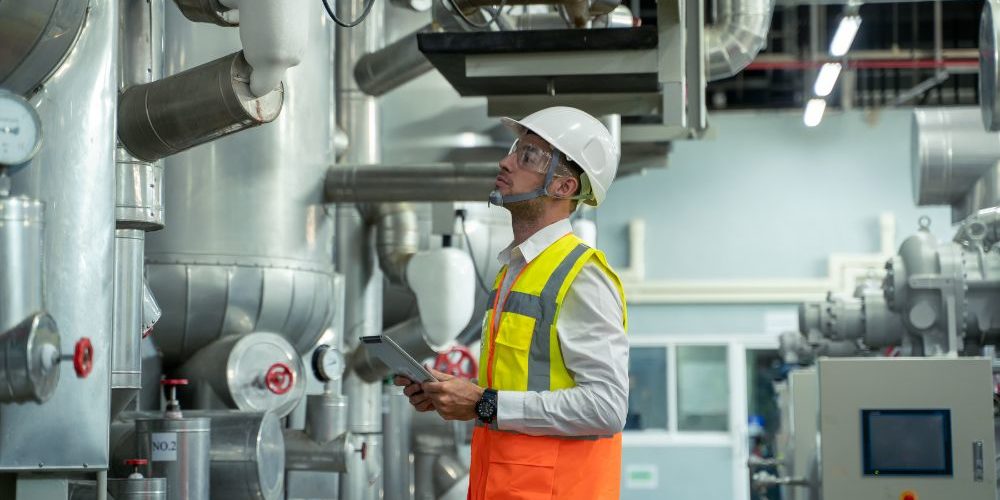Chemical manufacturing plants are fascinating facilities. They are responsible for producing a diverse variety of products we use daily. With that said, these places can also present quite a few hazards for those working there. After all, they are in close contact with numerous chemical substances. Plus, working in a chemical manufacturing plant requires heavy equipment and more.
For these reasons, it’s crucial to understand which injuries your staff might be at risk for. Moreover, knowing how to prevent injuries in your chemical manufacturing facility is imperative. Read on to learn more about the risks and how to protect your staff from them.
Common Injuries and What Causes Them
Before delving into how to prevent injuries in your plant, it’s crucial to understand which are most common and why. Indeed, any number of things can happen while on the job. But it seems as though a few types of hazards occur in chemical manufacturing plants most often.
We’ve listed and described each of them below.
Chemical Burns
It shouldn’t come as a shock that chemical burns are at the top of our list of common plant injuries. Chemical manufacturers are surrounded by myriad chemicals daily.
And whether acidic or base in nature, many of these chemicals can be harmful when they come into contact with skin. Plant workers that accidentally expose themselves to these chemicals experience burns.
The Cause
There are various reasons chemical burns occur in manufacturing plants, including:
- Poorly labeled containers or disorganized storage facilities
- Lack of training and knowledge of chemicals stored in the plant
- Failure to adhere to proper safety procedures
- Failure to wear and utilize appropriate protective equipment
But chemical burns aren’t the only injury common in manufacturing plants.
Exhaustion and Overexertion
Exhaustion and overexertion are other types of injuries common to chemical manufacturing environments. This isn’t your run-of-the-mill tiredness or muscle ache, either. No sort of exhaustion or overexertion is good, but the type we’re referring to poses a much more immediate risk. This is especially in the context of an industrial setting.
Plant workers will often work themselves to the point of extreme exhaustion. This means they’ve worked much longer than they should have without resting or taking the breaks necessary to do their jobs safely and effectively. Overexertion happens when an employee performs more labor than their bodies can handle. As a result, they often injure themselves.
The Cause
Many times, exhaustion and overexertion in chemical manufacturing plants are caused by:
- Working without adhering to proper break times
- Working overtime or much longer than one should
- Lifting more weight than one can carry properly
- Engaging in too much bending, lifting, or reaching
On the face of it, overexertion and exhaustion may not seem quite as serious as injuries like chemical burns. But make no mistake, as they are both serious hazards. Moreover, fatigue can result in other injuries if left unaddressed.
Slips, Trips, and Falls
Chemical toll manufacturing facilities are rife with heavy machinery, equipment, and loading and unloading docks. Due to the nature of the work, the floors typically comprise resin-coated concrete, which is very slick. As a result, slips, trips, and falls are among some of the most common workplace injuries chemical manufacturers experience.
The Cause
Like the other injuries discussed in this guide, slips, trips, and falls can happen for various reasons. But most of the time, they occur due to one of the following things:
- Lack of knowledge about safety procedures on the floor, such as keeping things tidy and out of the way
- Failure to provide proper signage for potential hazards, such as wet or greasy floors and trailing cables
- Improper lighting, unsuitable floor coverings, and uneven or damaged floors
- Improper use of equipment like ladders, step stools, and heavy machinery
These injuries often result from improper training, inadequate safety procedures and fail-safes, and unsuitable flooring and work environments.
Chemical Exposure and Inhalation
Chemical exposure and inhalation are also behind a lot of injuries that happen in chemical manufacturing plants. This makes sense. After all, working with chemicals is in the job description, and many of them can be hazardous when mishandled.
We’ve already discussed chemical burns. But chemical exposure and inhalation in chemical manufacturing facilities are just as common.
The Cause
These types of injuries almost always happen because of
- Employees cutting corners in their work processes
- Lack of up-to-date training on safety procedures and precautions
- Failure to utilize proper protective equipment and clothing
The good news is that you can prevent all of these common injuries in your chemical manufacturing plant with the proper safety strategies and improvement plans.
Safety Strategies and Improvement Plans
Most of the time, injuries happen on the job because a facility lacks efficiency, transparency, and training. Any chemical manufacturing plant can find itself dealing with these types of issues.
But when you do, it’s crucial to understand how you can strengthen your weak points. Doing so will help you provide workers with all the proper tools and resources they need to stay out of harm’s way. Let’s take a look at some basic areas you should evaluate and strengthen to prevent injuries in the workplace.
Training and Education
Many of the injuries we discussed in this guide result from improper training and education. For this reason, continual training and education for your staff is an excellent way to make your chemical manufacturing plant safer. Monthly refresher courses and safety training are a fantastic place to start.
You might also consider investing in new signage for your facility. These new signs can clearly outline all the proper safety procedures, work processes, and best practices in each area of your plant. Giving each employee a laminated copy of safety rules and procedures is also wise.
Doing so will ensure they have little excuse for cutting corners or ignoring the proper procedures. This goes for everything from chemical storage to protective equipment and even scheduled break times.
Install and Maintain Safety Equipment
It’s also a good idea to install safety equipment that can help keep your staff safe. This includes all forms of PPE and OSHA-standard safety equipment—but it also means branching out and finding innovative ways to protect your team. For instance, if your floors are notoriously slick, placing a few safety mats around might be wise.
Just make sure all additional equipment adheres to the proper guidelines and regulations. Hopefully, we were able to help identify some common injuries in chemical manufacturing plants and help you prevent them in your facility.








